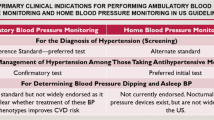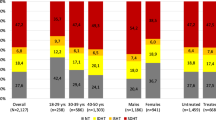Abstract
This study compared the ability of guideline-proposed office blood pressure (OBP) screening thresholds [European Society of Hypertension (ESH) guidelines: 130/85 mmHg for individuals with an OBP < 140/90 mmHg; American College of Cardiology/American Heart Association (ACC/AHA) guidelines: 120/75 mmHg for individuals with an OBP < 130/80 mmHg] and novel screening scores to identify normotensive individuals at high risk of having masked hypertension (MH) in an office setting. We cross-sectionally evaluated untreated participants with an OBP < 140/90 mmHg (n = 22,266) and an OBP < 130/80 mmHg (n = 10,005) who underwent home blood pressure monitoring (HBPM) (derivation cohort) from 686 Brazilian sites. MH was defined according to criteria suggested by the ESH (OBP < 140/90 mmHg; HBPM ≥ 135/85 mmHg), Brazilian Society of Cardiology (BSC) (OBP < 140/90 mmHg; HBPM ≥ 130/80 mmHg) and ACC/AHA (OBP < 130/80 mmHg; HBPM ≥ 130/80 mmHg). Scores were generated from multivariable logistic regression coefficients between MH and clinical variables (OBP, age, sex, and BMI). Considering the ESH, BSC, and ACC/AHA criteria, 17.2%, 38.5%, and 21.2% of the participants had MH, respectively. Guideline-proposed OBP screening thresholds yielded area under curve (AUC) values of 0.640 (for ESH criteria), 0.641 (for BSC criteria), and 0.619 (for ACC/AHA criteria) for predicting MH, while scores presented as continuous variables or quartiles yielded AUC values of 0.700 and 0.688 (for ESH criteria), 0.720 and 0.709 (for BSC criteria), and 0.671 and 0.661 (for ACC/AHA criteria), respectively. Further analyses performed with alternative untreated participants (validation cohort; n = 2807 with an OBP < 140/90 mmHg; n = 1269 with an OBP < 130/80 mmHg) yielded similar AUC values. In conclusion, the accuracy of guideline-proposed OBP screening thresholds in identifying individuals at high risk of having MH in an office setting is limited and is inferior to that yielded by scores derived from simple clinical variables.
This is a preview of subscription content, access via your institution
Access options
Subscribe to this journal
Receive 12 print issues and online access
$259.00 per year
only $21.58 per issue
Buy this article
- Purchase on Springer Link
- Instant access to full article PDF
Prices may be subject to local taxes which are calculated during checkout


Similar content being viewed by others
References
Lovibond K, Jowett S, Barton P, Caulfield M, Heneghan C, Hobbs FD, et al. Cost-effectiveness of options for the diagnosis of high blood pressure in primary care: a modelling study. Lancet. 2011;378:1219–30.
Whelton PK, Carey RM, Aronow WS, Casey DE Jr, Collins KJ, Dennison Himmelfarb C, et al. ACC/AHA/AAPA/ABC/ACPM/AGS/APhA/ASH/ASPC/NMA/PCNA guideline for the prevention, detection, evaluation, and management of high blood pressure in adults: executive summary: a report of the American College of Cardiology/American Heart Association Task Force on Clinical Practice Guidelines. J Am Coll Cardiol. 2017;2018:2199–269.
Williams B, Mancia G, Spiering W, Agabiti Rosei E, Azizi M, Burnier M, et al. Practice guidelines for the management of arterial hypertension of the European Society of Hypertension and the European Society of Cardiology: ESH/ESC Task Force for the Management of Arterial Hypertension. J Hypertens. 2018;2018:2284–309.
Barroso WKS, Rodrigues CIS, Bortolotto LA, Mota-Gomes MA, Brandão AA, Feitosa ADM, et al. Brazilian Guidelines of Hypertension—2020. Arq Bras Cardiol. 2021;116:516–658.
Palla M, Saber H, Konda S, Briasoulis A. Masked hypertension and cardiovascular outcomes: an updated systematic review and meta-analysis. Integr Blood Press Control. 2018;11:11–24.
Thakkar HV, Pope A, Anpalahan M. Masked hypertension: a systematic review. Heart Lung Circ. 2020;29:102–11.
Anstey DE, Moise N, Kronish I, Abdalla M. Masked hypertension: whom and how to screen? Curr Hypertens Rep. 2019;21:26.
Wang GL, Li Y, Staessen JA, Lu L, Wang JG. Anthropometric and lifestyle factors associated with white-coat, masked and sustained hypertension in a Chinese population. J Hypertens. 2007;25:2398–405.
Trudel X, Brisson C, Larocque B, Milot A. Masked hypertension: different blood pressure measurement methodology and risk factors in a working population. J Hypertens. 2009;27:1560–7.
Hänninen MR, Niiranen TJ, Puukka PJ, Mattila AK, Jula AM. Determinants of masked hypertension in the general population: the Finn-Home study. J Hypertens. 2011;29:1880–8.
Alwan H, Pruijm M, Ponte B, Ackermann D, Guessous I, Ehret G, et al. Epidemiology of masked and white-coat hypertension: the family-based SKIPOGH study. PLoS One. 2014;9:e92522.
Odili AN, Thijs L, Hara A, Wei FF, Ogedengbe JO, Nwegbu MM, et al. Prevalence and determinants of masked hypertension among black nigerians compared with a reference population. Hypertension. 2016;67:1249–55.
Feitosa ADM, Mota-Gomes MA, Barroso WS, Miranda RD, Barbosa ECD, Pedrosa RP, et al. Blood pressure cutoffs for white-coat and masked effects in a large population undergoing home blood pressure monitoring. Hypertens Res. 2019;42:1816–23.
Feitosa ADM, Mota-Gomes MA, Barroso WS, Miranda RD, Barbosa ECD, Pedrosa RP, et al. Relationship between office isolated systolic or diastolic hypertension and white-coat hypertension across the age spectrum: a home blood pressure study. J Hypertens. 2020;38:663–70.
Feitosa ADM, Mota-Gomes MA, Barroso WS, Miranda RD, Barbosa ECD, Pedrosa RP, et al. Correlation between office and home blood pressure in clinical practice: a comparison with 2017 American College of Cardiology/American Heart Association Hypertension Guidelines recommendations. J Hypertens. 2020;38:179–81.
Feitosa ADM, Mota-Gomes MA, Barroso WS, Miranda RD, Barbosa ECD, Brandão AA, et al. The impact of changing home blood pressure monitoring cutoff from 135/85 to 130/80 mmHg on hypertension phenotypes. J Clin Hypertens. 2021;23:1447–51.
Feitosa FGAM, Feitosa ADM, Paiva AMG, Mota-Gomes MA, Barroso WS, Miranda RD, et al. Impact of the COVID-19 pandemic on blood pressure control: a nationwide home blood pressure monitoring study. Hypertens Res. 2022;45:364–8.
Feitosa ADM, Mota-Gomes MA, Miranda RD, Barroso WS, Barbosa ECD, Pedrosa RP, et al. Impact of 2017 ACC/AHA hypertension guidelines on the prevalence of white-coat and masked hypertension: a home blood pressure monitoring study. J Clin Hypertens. 2018;20:1745–7.
Feitosa ADM, Mota-Gomes MA, Nadruz W. How should treated hypertensive patients with systolic blood pressure below 120 mmHg be managed? Eur Heart J. 2019;40:2089–90.
Cuspidi C, Facchetti R, Bombelli M, Sala C, Tadic M, Grassi G, et al. Risk of new-onset metabolic syndrome associated with white-coat and masked hypertension: data from a general population. J Hypertens. 2018;36:1833–9.
Gorostidi M, Vinyoles E, Banegas JR, de la Sierra A. Prevalence of white-coat and masked hypertension in national and international registries. Hypertens Res. 2015;38:1–7.
Hung MH, Shih LC, Wang YC, Leu HB, Huang PH, Wu TC, et al. Prediction of masked hypertension and masked uncontrolled hypertension using machine learning. Front Cardiovasc Med. 2021;8:778306.
Parati G, Stergiou GS, Bilo G, Kollias A, Pengo M, Ochoa JE, et al. Home blood pressure monitoring: methodology, clinical relevance and practical application: a 2021 position paper by the Working Group on Blood Pressure Monitoring and Cardiovascular Variability of the European Society of Hypertension. J Hypertens. 2021;39:1742–67.
Coll-de-Tuero G, Saez M, Roca-Saumell C, Rodriguez-Poncelas A, Franco P, Dalfó A, et al. Evolution of target organ damage by different values of self-blood pressure measurement in untreated hypertensive patients. Am J Hypertens. 2012;25:1256–63.
Niiranen TJ, Asayama K, Thijs L, Johansson JK, Ohkubo T, Kikuya M, et al. Outcome-driven thresholds for home blood pressure measurement: international database of home blood pressure in relation to cardiovascular outcome. Hypertension. 2013;61:27–34.
Park JS, Rhee MY, Namgung J, Lee SY, Cho DK, Choi TY, et al. Comparison of optimal diagnostic thresholds of hypertension with home blood pressure monitoring and 24-hour ambulatory blood pressure monitoring. Am J Hypertens. 2017;30:1170–6.
Feitosa ADM, Mota-Gomes MA, Nobre F, Mion D Jr, Paiva AMG, Argenta F, et al. What are the optimal reference values for home blood pressure monitoring? Arq Bras Cardiol. 2021;116:501–3.
Cuspidi C, Sala C, Tadic M, Grassi G. When office blood pressure is not enough: the case of masked hypertension. Am J Hypertens. 2019;32:225–33.
Stergiou GS, Salgami EV, Tzamouranis DG, Roussias LG. Masked hypertension assessed by ambulatory versus home blood pressure monitoring: is it the same phenomenon? Am J Hypertens. 2005;18:772–8.
Stergiou GS, Kyriakoulis KG, McManus RJ, Andreadis EA, Jula A, Kollias A, et al. Phenotypes of masked hypertension: isolated ambulatory, isolated home and dual masked hypertension. J Hypertens. 2020;38:218–23.
Franklin SS, O’Brien E, Staessen JA. Masked hypertension: understanding its complexity. Eur Heart J. 2017;38:1112–8.
Funding
The study was supported by the Brazilian National Council for Scientific and Technological Development (CNPq; grant 310869/2021-8 to WN and grant 313481/2020-2 to WSB).
Author information
Authors and Affiliations
Corresponding author
Ethics declarations
Conflict of interest
ADMF, MAM-G, WSB, AAB, RDM, and ECDB are the owners of the online TELEMRPA platform (Beliva, Brazil). ADMF, MAM-G and WSB are consultants for Omron.
Additional information
Publisher’s note Springer Nature remains neutral with regard to jurisdictional claims in published maps and institutional affiliations.
Supplementary information
Rights and permissions
Springer Nature or its licensor (e.g. a society or other partner) holds exclusive rights to this article under a publishing agreement with the author(s) or other rightsholder(s); author self-archiving of the accepted manuscript version of this article is solely governed by the terms of such publishing agreement and applicable law.
About this article
Cite this article
Alves, M.A.M., Feitosa, A.D.M., Mota-Gomes, M.A. et al. Accuracy of screening strategies for masked hypertension: a large-scale nationwide study based on home blood pressure monitoring. Hypertens Res 46, 742–750 (2023). https://doi.org/10.1038/s41440-022-01103-y
Received:
Revised:
Accepted:
Published:
Issue Date:
DOI: https://doi.org/10.1038/s41440-022-01103-y
Keywords
This article is cited by
-
2023 update and perspectives
Hypertension Research (2024)
-
Masked hypertension: how not to miss an even more silent killer
Hypertension Research (2023)



